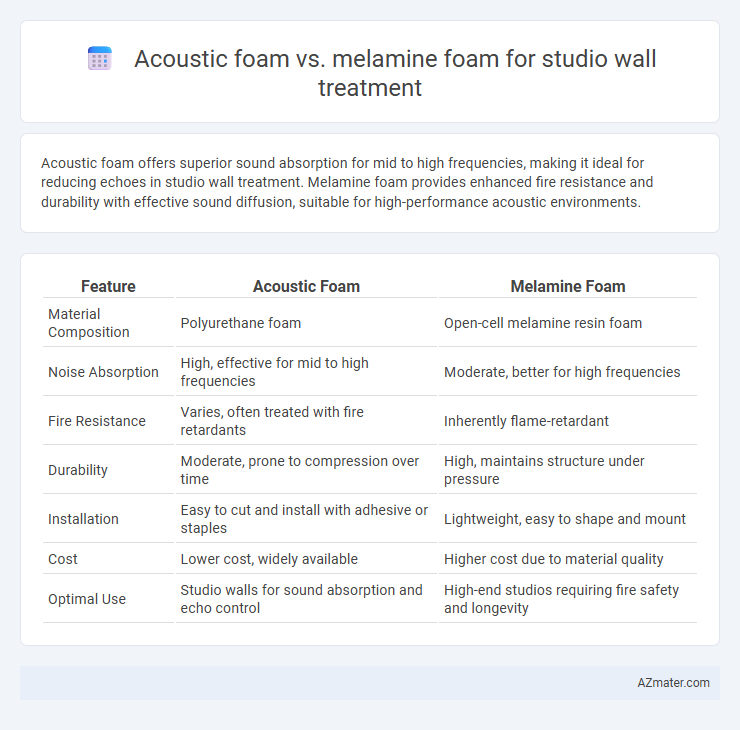Acoustic foam offers superior sound absorption for mid to high frequencies, making it ideal for reducing echoes in studio wall treatment. Melamine foam provides enhanced fire resistance and durability with effective sound diffusion, suitable for high-performance acoustic environments.
Table of Comparison
| Feature | Acoustic Foam | Melamine Foam |
|---|---|---|
| Material Composition | Polyurethane foam | Open-cell melamine resin foam |
| Noise Absorption | High, effective for mid to high frequencies | Moderate, better for high frequencies |
| Fire Resistance | Varies, often treated with fire retardants | Inherently flame-retardant |
| Durability | Moderate, prone to compression over time | High, maintains structure under pressure |
| Installation | Easy to cut and install with adhesive or staples | Lightweight, easy to shape and mount |
| Cost | Lower cost, widely available | Higher cost due to material quality |
| Optimal Use | Studio walls for sound absorption and echo control | High-end studios requiring fire safety and longevity |
Introduction: Acoustic Foam vs Melamine Foam
Acoustic foam and melamine foam are popular materials used for studio wall treatment, each with distinct acoustic properties. Acoustic foam, typically made from polyurethane, excels in absorption of mid to high-frequency sound waves, reducing echo and reverberation. Melamine foam offers superior fire resistance and lightweight characteristics, making it effective for soundproofing and thermal insulation in studio environments.
Understanding Acoustic Foam: Composition and Properties
Acoustic foam is typically made from polyurethane or melamine resin, designed to absorb mid to high-frequency sound waves, reducing echo and reverberation within a studio environment. Its open-cell structure and density provide excellent sound absorption while maintaining fire resistance and lightweight characteristics. Melamine foam, a specific type of acoustic foam, offers superior thermal insulation and higher noise reduction coefficients, making it an ideal choice for professional studio wall treatment applications.
Melamine Foam: Structure and Key Characteristics
Melamine foam is an open-cell, rigid foam composed of melamine resin, known for its lightweight and fire-resistant properties crucial in studio wall treatment. Its microstructure features a high porosity with interconnected pores, enabling superior sound absorption, particularly in mid to high frequencies, which reduces echo and reverberation effectively. Unlike acoustic foam, melamine foam offers enhanced thermal insulation and greater durability, making it an optimal choice for long-term acoustic performance in professional studio environments.
Sound Absorption Performance Compared
Acoustic foam typically offers superior low to mid-frequency sound absorption due to its open-cell polyurethane structure, making it ideal for reducing echo and reverberation in studio environments. Melamine foam excels in high-frequency sound absorption thanks to its rigid, porous structure, which effectively diffuses and absorbs higher-pitched sounds. For comprehensive studio wall treatment, combining both materials can optimize sound absorption across a broader frequency range.
Fire Resistance: Safety Considerations
Melamine foam offers superior fire resistance compared to standard acoustic foam, making it a safer choice for studio wall treatments where fire safety is critical. Acoustic foam, typically made from polyurethane, is more flammable and may require additional fire retardant treatments to meet safety codes. Prioritizing melamine foam enhances compliance with fire safety regulations while maintaining effective sound absorption in studio environments.
Durability and Longevity in Studio Environments
Acoustic foam, typically made from polyurethane, offers moderate durability with resistance to compression but may degrade faster under prolonged exposure to sunlight and humidity. Melamine foam exhibits superior longevity due to its rigid structure, high thermal stability, and better resistance to moisture, making it ideal for harsh studio environments. Studios seeking long-term wall treatment solutions often prefer melamine foam for its resilience and consistent acoustic performance over time.
Installation Process and Maintenance Requirements
Acoustic foam offers straightforward installation, typically using adhesive sprays or mounting strips, and requires minimal maintenance beyond routine dusting. Melamine foam demands careful cutting and sometimes additional framing for secure placement, with cleaning generally limited to gentle vacuuming to avoid damage. Both materials resist moisture and do not degrade easily, but acoustic foam tends to be more flexible for DIY setups while melamine foam benefits from higher fire resistance and durability in professional studio environments.
Aesthetic Options: Colors and Design Flexibility
Acoustic foam offers a wide range of vibrant colors and customizable shapes, making it ideal for visually dynamic studio wall treatments that enhance both soundproofing and aesthetic appeal. Melamine foam, typically available in neutral tones like white or gray, provides a more minimalist and modern look but offers less design flexibility compared to acoustic foam. Choosing between these materials depends on whether vibrant color schemes and creative patterns or understated elegance better suit the studio environment.
Cost Analysis: Budgeting for Studio Wall Treatment
Acoustic foam typically offers a lower initial cost than melamine foam, making it a budget-friendly choice for studio wall treatment while still providing effective sound absorption. Melamine foam, although more expensive, delivers superior fire resistance and durability, which can reduce long-term replacement costs in professional studio environments. Factoring in these cost-benefit aspects helps in budgeting a studio wall treatment that balances performance requirements with available financial resources.
Conclusion: Choosing the Right Foam for Your Studio
Acoustic foam provides superior sound absorption, targeting mid to high frequencies effectively, making it ideal for vocal clarity in studios. Melamine foam offers a lightweight, fire-resistant option with broad-spectrum absorption but less density, suitable for large spaces or budget-conscious projects. Selecting the right foam depends on your studio's acoustic needs, space constraints, and safety requirements to optimize sound quality and durability.

Infographic: Acoustic foam vs Melamine foam for Studio wall treatment
 azmater.com
azmater.com